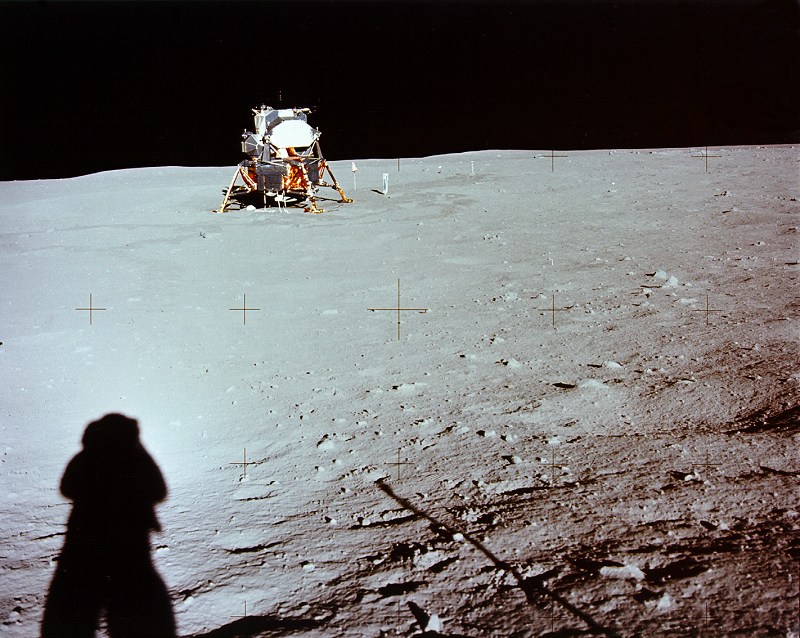تثبيت التطبيق
How to install the app on iOS
Follow along with the video below to see how to install our site as a web app on your home screen.
ملاحظة: This feature may not be available in some browsers.
أنت تستخدم أحد المتصفحات القديمة. قد لا يتم عرض هذا الموقع أو المواقع الأخرى بشكل صحيح.
يجب عليك ترقية متصفحك أو استخدام أحد المتصفحات البديلة.
يجب عليك ترقية متصفحك أو استخدام أحد المتصفحات البديلة.
ناسا تكشف عن منشآت على سطح القمر
- بادئ الموضوع فادي الشام
- تاريخ البدء
هذه المعلومة شاهدتها في الفلم الوثائقي unacknowledged حيث جاء في شهادة احد العلماء ان امسترونغ لما نزل على سطح القمر بدأ الاتصال مع المحطة الارضية نازا و أثناء حديتهم قال لهم يبدو انا هناك من سبقنا الى القمر .. فطلبوا منه تاكيد ما قال حيث ضنوا ان هناك تشويش فقالها مرة أخرى فسالوه ماذا تعني فقال هناك منشأت على سطح القمر !!! فتكتمت نازا عن الامر ... ادعوكم لمشاهدة الفلم
هذه المعلومة شاهدتها في الفلم الوثائقي unacknowledged حيث جاء في شهادة احد العلماء ان امسترونغ لما نزل على سطح القمر بدأ الاتصال مع المحطة الارضية نازا و أثناء حديتهم قال لهم يبدو انا هناك من سبقنا الى القمر .. فطلبوا منه تاكيد ما قال حيث ضنوا ان هناك تشويش فقالها مرة أخرى فسالوه ماذا تعني فقال هناك منشأت على سطح القمر !!! فتكتمت نازا عن الامر ... ادعوكم لمشاهدة الفلم
قريباً سيتم ارسال العشرات من الرحلات الى القمر والمريخ، اذا كانت تلك الامور صحيحة فسيتم اكتشافها بسهوله
هناك من يقول بان هذا هو السبب في عدم رجوع نازا للقمر والله اعلم نحن فقط مستهلكين للاسف جميع الاسرار بحوزتهم
اهتمام العرب بالأرز لم يترك مجالاً لهذا طيلة ال50 عاماً السابقة
مركبات ناسا هبطت على القمر ست مراتهناك من يقول بان هذا هو السبب في عدم رجوع نازا للقمر والله اعلم نحن فقط مستهلكين للاسف جميع الاسرار بحوزتهم
Laser Ranging Retroreflector
 The Laser Ranging Retroreflector experiment was deployed on Apollo 11, 14, and 15. It consists of a series of corner-cube reflectors, which are a special type of mirror with the property of always reflecting an incoming light beam back in the direction it came from. A similar device was also included on the Soviet Union's Lunakhod 2spacecraft. These reflectors can be illuminated by laser beams aimed through large telescopes on Earth. The reflected laser beam is also observed with the telescope, providing a measurement of the round-trip distance between Earth and the Moon. This is the only Apollo experiment that is still returning data from the Moon. Many of these measurements have been made by McDonald Observatory in Texas. From 1969 to 1985, they were made on a part-time basis using the McDonald Observatory 107-inch telescope. Since 1985, these observations have been made using a dedicated 30-inch telescope. Additional measurements have been made by observatories in Hawaii, California, France, Australia, and Germany.
The Laser Ranging Retroreflector experiment was deployed on Apollo 11, 14, and 15. It consists of a series of corner-cube reflectors, which are a special type of mirror with the property of always reflecting an incoming light beam back in the direction it came from. A similar device was also included on the Soviet Union's Lunakhod 2spacecraft. These reflectors can be illuminated by laser beams aimed through large telescopes on Earth. The reflected laser beam is also observed with the telescope, providing a measurement of the round-trip distance between Earth and the Moon. This is the only Apollo experiment that is still returning data from the Moon. Many of these measurements have been made by McDonald Observatory in Texas. From 1969 to 1985, they were made on a part-time basis using the McDonald Observatory 107-inch telescope. Since 1985, these observations have been made using a dedicated 30-inch telescope. Additional measurements have been made by observatories in Hawaii, California, France, Australia, and Germany.
Laser beams are used because they remain tightly focused for large distances. Nevertheless, there is enough dispersion of the beam that it is about 7 kilometers in diameter when it reaches the Moon and 20 kilometers in diameter when it returns to Earth. Because of this very weak signal, observations are made for several hours at a time. By averaging the signal for this period, the distance to the Moon can be measured to an accuracy of about 3 centimeters (the average distance from the Earth to the Moon is about 385,000 kilometers).
The Laser Ranging Retroreflector experiment has produced many important measurements. These include an improved knowledge of the Moon's orbit and the rate at which the Moon is receding from Earth (currently 3.8 centimeters per year) and of variations in the rotation of the Moon. These variations in rotation are related to the distribution of mass inside the Moon and imply the existence of a small core, with a radius of less than 350 kilometers, somewhat smaller than the limits imposed by the passive seismic and magnetometer experiments. These measurements have also improved our knowledge of changes of the Earth's rotation rate and the precession of its spin axis and have been used to test Einstein's theory of relativity.
https://www.lpi.usra.edu/lunar/missions/apollo/apollo_11/experiments/lrr/

Laser beams are used because they remain tightly focused for large distances. Nevertheless, there is enough dispersion of the beam that it is about 7 kilometers in diameter when it reaches the Moon and 20 kilometers in diameter when it returns to Earth. Because of this very weak signal, observations are made for several hours at a time. By averaging the signal for this period, the distance to the Moon can be measured to an accuracy of about 3 centimeters (the average distance from the Earth to the Moon is about 385,000 kilometers).
The Laser Ranging Retroreflector experiment has produced many important measurements. These include an improved knowledge of the Moon's orbit and the rate at which the Moon is receding from Earth (currently 3.8 centimeters per year) and of variations in the rotation of the Moon. These variations in rotation are related to the distribution of mass inside the Moon and imply the existence of a small core, with a radius of less than 350 kilometers, somewhat smaller than the limits imposed by the passive seismic and magnetometer experiments. These measurements have also improved our knowledge of changes of the Earth's rotation rate and the precession of its spin axis and have been used to test Einstein's theory of relativity.
https://www.lpi.usra.edu/lunar/missions/apollo/apollo_11/experiments/lrr/
فلم indepedance day فلم جميل للمخلوقات الفضائية ،برامج حاسوبية تجعلك تصدق ان المركبات حقيقية ونفس الشئ ببرامج اكثر تطورا للناسا والمعاهد الامريكية للبحث العلمي لفائدة البنتاغون والجيش الامريكي وهنا ساطرح سؤالا اخر هل تعتقدون في وجود القنبلة الذرية؟؟بالعلم وليس بالايمان؟؟
بالنسبة للقنبلة، اسأل اليابان وكيف تهاوت اعظم امبراطورية حينها بسبب (قنيبلتين) ذرية !!


